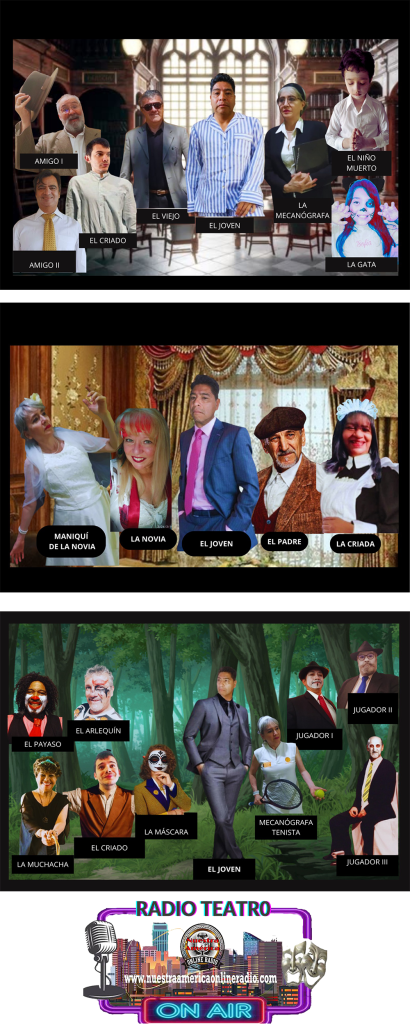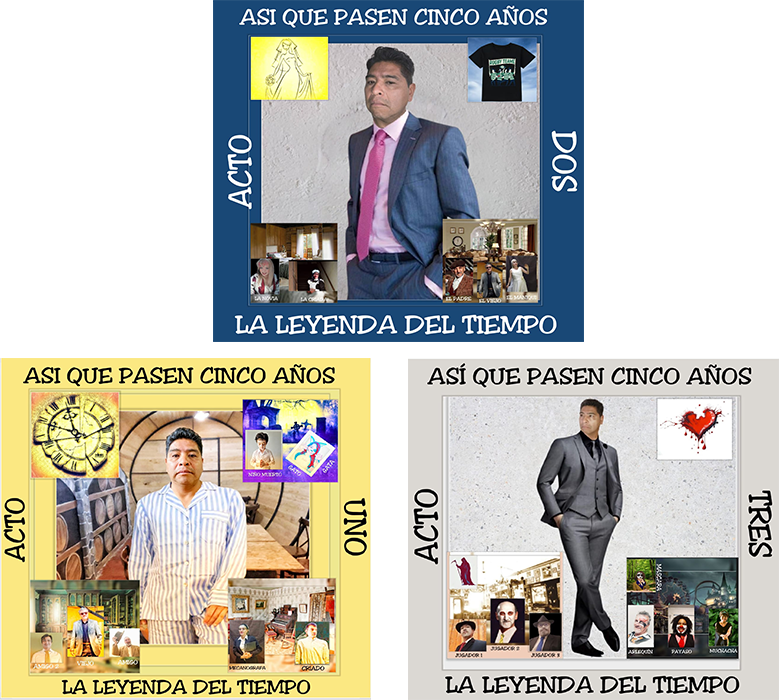«So five years go by»: The characters and the music
By Teresa
Fernandez Herrera. Journalist, writer. Global Chief Executive Officer of
Culture.
Federico García Lorca creó hace casi un siglo para los personajes sin nombre propio de su obra “Así que pasen cinco años”, publicada en Madrid en agosto de 1931, una serie de disfraces o atuendos con que identificar a los actores y actrices en las representaciones teatrales, que por circunstancias adversas que todos conocemos, una guerra, la muerte del autor y una dictadura, tardaron muchos años en producirse.
Almost a century ago, Federico García Lorca created a series of costumes or outfits for the characters without their own name in his work “So five years pass,” published in Madrid in August 1931, with which to identify the actors and actresses in the performances. theatrical works, which due to adverse circumstances that we all know, a war, the death of the author and a dictatorship, took many years to produce.
Nuestra América online radio, veterana anfitriona de muchas obras de teatro lorquianas, para que los radioescuchas del estreno el próximo 18 de abril de “Así que pasen cinco años”, ha querido familiarizar a su público por medio de una amplia cobertura informativa previa, con estos personajes con imágenes fotográficas creadas con este objetivo.
Nuestra América online radio, veteran host of many Lorca plays, has wanted to familiarize its audience with extensive prior information coverage, so that listeners of the premiere on April 18 of “So five years pass” these characters with photographic images created with this objective.

Seis carteles, dos de cada uno de sus tres actos, de dos estilos distintos, de sus dos creadores, familiarizarán a nuestros lectores con las imágenes de unos personajes de los que vamos a hablar un poco.
Six posters, two for each of its three acts, of two different styles, by its two creators, will familiarize our readers with the images of some characters that we are going to talk a little about.
Solo el protagonista, El Joven, está presente en los tres actos. Aparece en pijama en el acto primero, en la biblioteca de su casa. Un Viejo ataviado con traje negro dialoga con él largamente. Van apareciendo, un amigo vestido informalmente. Una mecanógrafa, vestida como una secretaria de aquellos años. Un Niño muerto vestido de blanco un poco actualizado a nuestros días; Federico lo vistió de Primera Comunión con una corona de rosas blancas en la cabeza; un Gato que luego resulta ser una Gata, con su naricilla, sus bigotes y orejitas; un criado, vestido de formal mayordomo, aquí cambiado un poco, siempre respetuosos con el espíritu lorquiano. Un Amigo segundo que hace un siglo vestía traje de lana blanco con grandes botones azules, ahora en el siglo XXI va simplemente con camisa blanca, porque hace calor.
Only the protagonist, The Young Man, is present in all three acts. He appears in his pajamas in the first act, in his home library. An old man dressed in a black suit talks to him at length. They appear, a friend dressed casually. A typist, dressed like a secretary from those years. A dead Child dressed in white a little updated to our days; Federico dressed him for First Communion with a crown of white roses on his head; a Cat who later turns out to be a Cat, with her little nose, her whiskers and her little ears; a servant, dressed as a formal butler, here changed a little, always respectful of the Lorca spirit. A second Friend who a century ago wore a white wool suit with big blue buttons, now in the 21st century he simply wears a white shirt, because it is hot.
En el acto segundo verán a un Joven en traje de calle y corbata. La Novia en su dormitorio, va cubierta por una elegante bata; su padre, que hace un siglo iba de traje negro, ahora, como astrónomo aficionado y bohemio se ha vestido de sport, con una elegante gorra; la Criada de la Novia se ha mantenido fiel al uniforme negro con delantal y cofia blancos. Y un Maniquí que habla, viste un traje de novia, que nunca se pondrá nadie.
In the second act you will see a young man in a street suit and tie. The Bride in her bedroom is covered in an elegant robe; his father, who a century ago wore a black suit, now, as an amateur and bohemian astronomer, has dressed casually, with an elegant cap; The Bride’s Maid has remained faithful to the black uniform with white apron and cap. And a Mannequin that talks, wears a wedding dress, which no one will ever wear.
En el definitivo acto tercero que comienza en un extraño bosque con un pequeño teatrillo en el corazón de ese bosque, veremos pasar a un Arlequín, una Muchacha vestida hace un siglo con túnica griega negra, ahora viste un elegante vestido negro de tarde; Una máscara, muy surrealista que representa … no, no, no vamos a revelar aquí a quién representa… y un Payaso, un Payaso auténtico de la Commedia del’Arte. Vuelven el Criado y la Criada y por supuesto el Joven, a quien hemos vestido con su último atuendo, un elegante traje de tarde/noche. Hay tres Jugadores, vestidos de negro, pero no de frac como hace un siglo. Sus caras son blancas como la cera; Hacen un juego bastante inquietante. Ya los están viendo, en sus carteles del acto tercero.
In the definitive third act that begins in a strange forest with a small theater in the heart of that forest, we will see a Harlequin pass by, a Girl dressed a century ago in a black Greek tunic, now wearing an elegant black afternoon dress; A very surreal mask that represents… no, no, we are not going to reveal here who it represents… and a Clown, an authentic Clown from the Commedia del’Arte. The Servant and the Maid return and of course the Young Man, whom we have dressed in his latest outfit, an elegant afternoon/evening suit. There are three Players, dressed in black, but not in tails like a century ago. Their faces are white as wax; They make a pretty disturbing game. You are already seeing them, on their posters for the third act.


Volverán a verlos, en la próxima sesión informativa que publicaremos en pocos días, de forma individualizada. Los conocerán mejor.
You will see them again, in the next information session that we will publish in a few days, individually. They will know them better.
Las músicas en Así que pasen cinco años / The music in Así pasen cinco años
Teniendo en cuenta que el principal protagonista en Así que pasen cinco años, es el TIEMPO, tiempo que tanto parece pasar como parece permanecer estático si estamos atentos a detalles de su lenguaje e imágenes; como por ejemplo, esos Niño y Gato muertos del acto primero, que alguien en el acto segundo, supuestamente cinco años más tarde, dice haber visto a unos niños apedreando a un gato y por el acto tercero pasa en determinado momento el Niño muerto; o el regreso a la biblioteca en la última escena de la obra, o las seis campanadas de un reloj en el acto primero y un buen rato más tarde sigue siendo la misma hora, o las engañosas doce campanadas del final, que en realidad son seis porque las otras seis las repite el eco; o el tiempo presente, pasado y futuro en el mismo plano y mil detalles más que revelará la obra en su estreno, nos han llevado a poner como leit motiv esa hermosa y obsesiva música de la Danza de las Horas, de la ópera La Gioconda, del compositor novecentista Amílcare Ponchielli, que inicia el acto primero y reaparece oportunamente en los tres actos.
Taking into account that the main protagonist in So Five Years Go By is TIME, time that both seems to pass and seems to remain static if we pay attention to the details of its language and images; such as, for example, those dead Boy and Cat from the first act, that someone in the second act, supposedly five years later, claims to have seen some children stoning a cat and in the third act the dead Boy passes by at a certain moment; or the return to the library in the last scene of the play, or the six strikes of a clock in the first act and a long time later it is still the same time, or the deceptive twelve strikes at the end, which are actually six because the other six are repeated by the echo; or the present, past and future time on the same plane and a thousand more details that the work will reveal in its premiere, have led us to put as leitmotiv that beautiful and obsessive music from the Dance of the Hours, from the opera La Gioconda, by the Noucentista composer Amílcare Ponchielli, who begins the first act and reappears opportunely in the three acts.
Para la escena final de la obra había varias opciones entre las que había que elegir. Al final nos decidimos por la Danza Macabra del compositor francés también novecentista Camille Saint Saëns, tras escucharla recientemente en un concierto.
For the final scene of the play there were several options to choose from. In the end we decided on the Danse Macabre by the French composer Camille Saint Saëns, also a Noucentista composer, after recently listening to it in concert.
Son músicas protagonistas en homenaje a García Lorca, sus canciones







No hay comentarios.:
Publicar un comentario